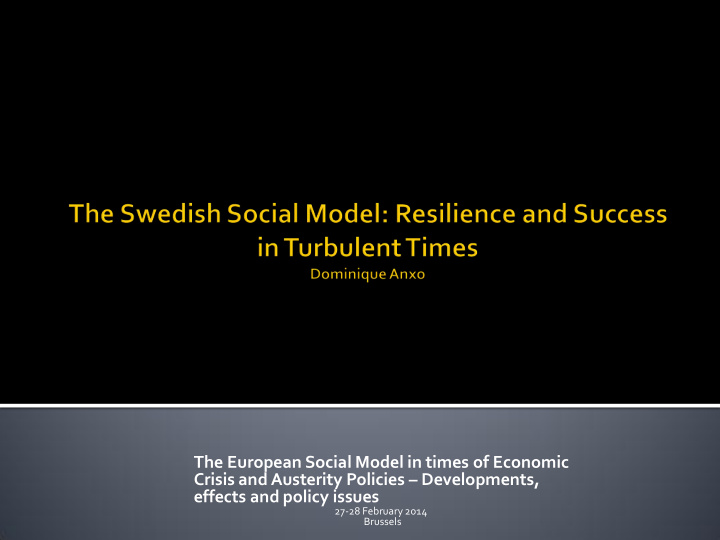



The European Social Model in times of Economic Crisis and Austerity Policies – Developments, effects and policy issues 27-28 February 2014 Brussels
Despite substantial transformations during the last two decades , the Swedish Social Model still shares many of the distinctive features, principles and core values of the European Social Model. Dominique Anxo
In the wake of the dramatic crisis of the early 1990s, several structural reforms and fiscal consolidation measures were initiated Reorientation of Macro-economic policy towards 1. more restrictive fiscal and monetary policy Retrenchment of the Swedish public sector and a 2. decline of public employment (A reduction of almost 20% between 1990 and 2008). Also reforms of social protection system (UB, SI) and 3. comprehensive pension reform. Stricter eligibility rules and lower replacement rates. Dominique Anxo
These reforms aimed to 1. re-establish macro-economic balance, 2. re- establish Sweden’s sovereignty and independence from the financial markets 3. And to secure the long-term sustainability of the Swedish Welfare State. Dominique Anxo
Distributional impacts The various reforms of the tax and social protection systems have contributed to an increase of income inequality. But Sweden has maintained its position as one of the most egalitarian economies in the world. Increased duality of the LM (modifications of employment protection act ) and weakening of the goal of full employment. Dominique Anxo
If these reforms, by strengthening the role of the market, have reduced the extent of de- commodification of the SSM, they have not threatened its architecture and coherence or the robustness of its social cohesion. The ‘ Swedish success story ’ during the 2008 recession cannot either be reduced to early fiscal consolidation measures. Dominique Anxo
It is is clear that, due to healthier public finances, the room for manoeuver for conducting a more expansionary macroeconomic policy was larger compared to the 1990s crisis. It is clear that this countercyclical fiscal and monetary policy has limited the negative impact of the crisis on employment, welfare and social exclusion. Dominique Anxo
Sweden, with its still large, encompassing and generous welfare state, has large automatic stabilizers that have absorbed a part of the macroeconomic chock and protected Swedish households from the impact of the 2008 economic downturn. Last but not least I want to insist on the crucial role of the social partners and a developed social dialogue : Wage moderation Dominique Anxo
To sum up: despite structural reforms the Swedish social model remains, by international standards, clearly universal, fairly generous and inclusive in nature and continues to enjoy a high level of across-the-board public support. The Swedish experience remains therefore a good illustration of the positive role played by healthy public finances, a strong social safety net and a developed social dialogue in front of severe macroeconomic shocks. Dominique Anxo
In other words , in a period of strong economic turbulences, the Swedish experience illustrates, in my view, the resilience , the success , and long- term viability of a societal model based on a universal and generous social protection system, egalitarianism and a strong public and political involvement in the provision of a wide range of social services. Dominique Anxo
Recommend
More recommend